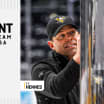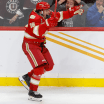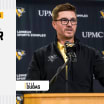The Penguins performance staff hears a familiar refrain from the development staff when it comes to younger players and prospects, especially around the NHL Draft.
"The common thing we hear all the time is this guy has got to get stronger, this guy has got to put on some muscle, this guy has got to put on a little bit more weight," strength and conditioning coach Alex Trinca said.
How Penguins Prospects Add Strength, Muscle and Weight

For example, Jake Guentzel is a guy who was 5-foot-9 and 155 pounds when he was drafted by the Penguins in the third round (77th overall) in 2013. He's now listed at 5-foot-11 and 180 pounds.
So how do the prospects go about packing on that strength, muscle and weight? Well, Trinca and fellow strength and conditioning coach Alexi Pianosi recently took the newest additions to the Penguins organization - members of the 2020 NHL Draft class - through
a crash course on how they can begin that process
. Some of it comes with genetics, but a lot of it comes through commitment.
RELATED LINKS
Draft Hub
Penguins Acquire Gruden and a 2020 2nd-Round Pick for Murray
Behind the Scenes of the Virtual NHL Draft
"Strength and conditioning encompasses sleep, your mental health and preparation, nutrition, soft tissue work, and your lifestyle choices away from the gym or the practice rink - what you're doing when you're not at the rink or training," Pianosi said.
"With you guys just sort of starting the process as prospects trying to work towards that goal of being NHL regulars, your goal should be to learn how they're all connected and how they can help your performance."
Pianosi explained the concepts for hockey training that the Penguins feel are most important - single-leg strength versus double-leg strength, the sit position and T-spine mobility.
Single-leg strength is important because the NHL has less time and space available on the ice, which creates an increased demand for single-leg strength to help with turning and multi-directional skating.
The idea behind the sit position, which means creating two parallel lines between the shin and torso, is to put the athlete in the best possible position to create forward speed on the first three strides.
And the T-spine, or thoracic spine, is an underrecognized and undertrained part of the body that is constantly working to balance what the lower body is doing. Making sure there is mobility in that area is crucial because it decreases the risk of injury to the neck, lower body and hips.
But ultimately, one of the biggest keys is performance nutrition.
It's a complicated process that depends on the individual athlete and what works best for their body, as there's so many different schools of thought: organic vs. non-organic, grass-fed vs. non grass-fed, paleo, carnivore, vegan - the list goes on.
In addition to that, some guys who play more minutes on a nightly basis might need more carbohydrates than others, while some guys respond well to high-fat diets.
But if the prospects start to dial all of that in right away, it can optimize their window and not only get them to the NHL sooner - but potentially extend their careers like it did for current development staff members Tom Kostopoulos and Matt Cullen.
"It just comes down to knowing yourself," Trinca said. "And especially as developmental athletes, really experimenting in this area and being aware of things - keeping a journal, knowing what you did that make you feel good - is an important aspect of development."
It boils down to the idea of calories in (food), calories out (exercise) and balance. And Trinca said when it comes to performance nutrition, there are three questions the prospects should be asking themselves: 1) What am I going to eat? 2) How much am I going to eat? 3) When am I going to eat?
1. WHAT AM I GOING TO EAT?
In order to gain weight, the prospects have to take in more calories than they put out by exercise. To do that, they're likely going to increase their protein intake; increase their carbohydrate intake; and increase their meal frequency by adding a fourth meal or a snack in addition to breakfast, lunch and dinner.
However, the Catch-22 to this is that in order to gain that weight, strength and muscle, the prospects typically have to work out more and add more resistance training to their regimen. So, as they burn more calories…
"You have to eat more food," Trinca said. "You have to eat, you have to eat, you have to eat. And that's eventually what gets you to the point of gaining weight."
The question of 'what do I eat' also depends on the type of activity a prospect does on any given day, and that's going to change as they progress through in-season to offseason and just through their careers in general depending on what league they're in.
For example, college players only have games on the weekend, whereas in the NHL they play virtually every other night.
So on a lighter day, an example of how to structure their diet would be to have a decent amount of lean protein, lots of fruits and vegetables and a small amount of grains. On a heavier day, they would increase that amount of grains. But no matter what their daily training regimen is, one aspect must always remain the same.
"To put on more muscle and to improve your overall body composition, you're always going to have to ingest protein in your system at the same amount," Trinca said.
Trinca said they find that one of the big misses for many young athletes is that protein intake.
"Guys are typically really good with their carbohydrate intake," he said. "You talk to every single developmental prospect out there, and their favorite meal is chicken and pasta. And really, it's like pasta with a side of chicken. It's a big mound of pasta with a ton of carbs and maybe a little bit of protein. And then maybe you'll sneak in a little bit of vegetable. But really, protein has to be the foundation of your plate."
He said that another area that can typically use improvement is their fruit and vegetable intake.
"The cool thing about this is that it's not just necessarily how fruit and vegetables contribute to your body mass or your body composition, but they have aspects that are really important like fiber, micronutrients, vitamins and minerals," Trinca said. "And a lot of those things contribute to your sleep, tissue quality, your energy levels and your ability to learn."
He advised prospects to "eat the rainbow" when it comes to their fruit and vegetable intake and try to get as many colors as possible on their plates.
One area that European players tend to be farther along than their North American counterparts in is adding healthy fats to their diets. Trinca advised them all to find ways to mix in more nuts, avocado, olive oil and more efficient red meat.
"Fat is such an important aspect, not in just helping balance out the diet, but allowing your brain to function really well," he said. "Allowing your nervous system to work really well at reducing the overall inflammation in your body."
And finally, when it comes to their carbohydrate intake, it's all about getting complex and unrefined ones.
"Those are really important in regulating your energy levels," Trinca said. "Really important after games to help get your legs back to where they need to be if you're in a back-to-back scenario or if you're in Wilkes-Barre playing a three-in-three."
And in each category, the idea of food selection is an important one to keep in mind. As Trinca said, having beef from a fast-food restaurant isn't as good as having grass-fed beef from a local farmer or a butcher.
2. HOW MUCH AM I GOING TO EAT?
When looking at serving sizes and how much food is important for an individual, the Penguins' typical rule of thumb (pun intended) is the person's hand.
For lean protein, they're typically looking at two palmfuls (the circular surface area of their palm, as well as the width).
For fruits and vegetables, they're typically looking at a fistful, or two fistfuls for leafy vegetables.
For whole grains and those complex and unrefined carbohydrates, they're typically looking at half a fistful, or one fist to a fist-and-a-half overall for the guys that are dealing with heavy training volumes on a day where they've got a 45- or 60-minute practice with a workout.
For healthy fats, they're typically looking for about two thumbfuls.
3. WHEN AM I GOING TO EAT?
The timing of a players' meals is a huge area of opportunity for them.
"There's a lot of implications on not just your body composition, your muscle mass and your body fat, but also your attentiveness and how well you learn," Trinca said. "How well you sleep, how well your body deals with inflammation - all of these things have foundations in nutrition."
It's important for the prospects to prioritize eating shortly after exercise, because their body ends up acting like a sponge and wants to absorb everything it's provided in that 30-minute to one hour and 15-minute window afterward.
"When we look at the activities - after practice, after practice and a lift, after a game, after a game and a lift - we're looking to get a combination of protein and carbs if you're also working out and probably a little bit more carbohydrate if you're just skating or doing something on the ice," Trinca said.
Before a game, Trinca said they're just looking to top off their fuel tank, so just having some carbs is all they might need.
"If you're a guy that has really high minutes - a goalie is a great example as a guy who's playing the whole game - he might need a little bit more carbohydrates then some of the other players," Trinca said.
But Trinca emphasized that this works on an individual basis, and finding what works is the important aspect. He also emphasized that eating for performance doesn't cancel out eating for pleasure, telling the prospects about how team chef Geoff Straub does a phenomenal job of making performance food taste good.
"It's finding a way to really merge those two worlds to get you to understand how important nutrition is to your overall performance," Trinca said.
















































